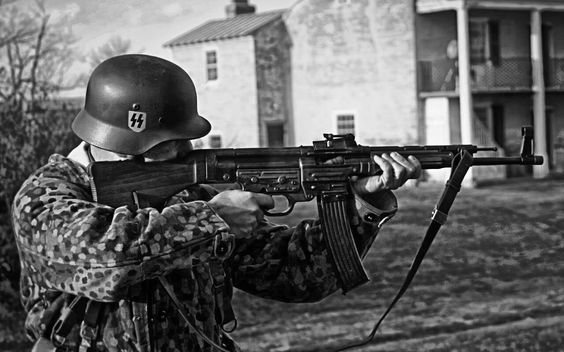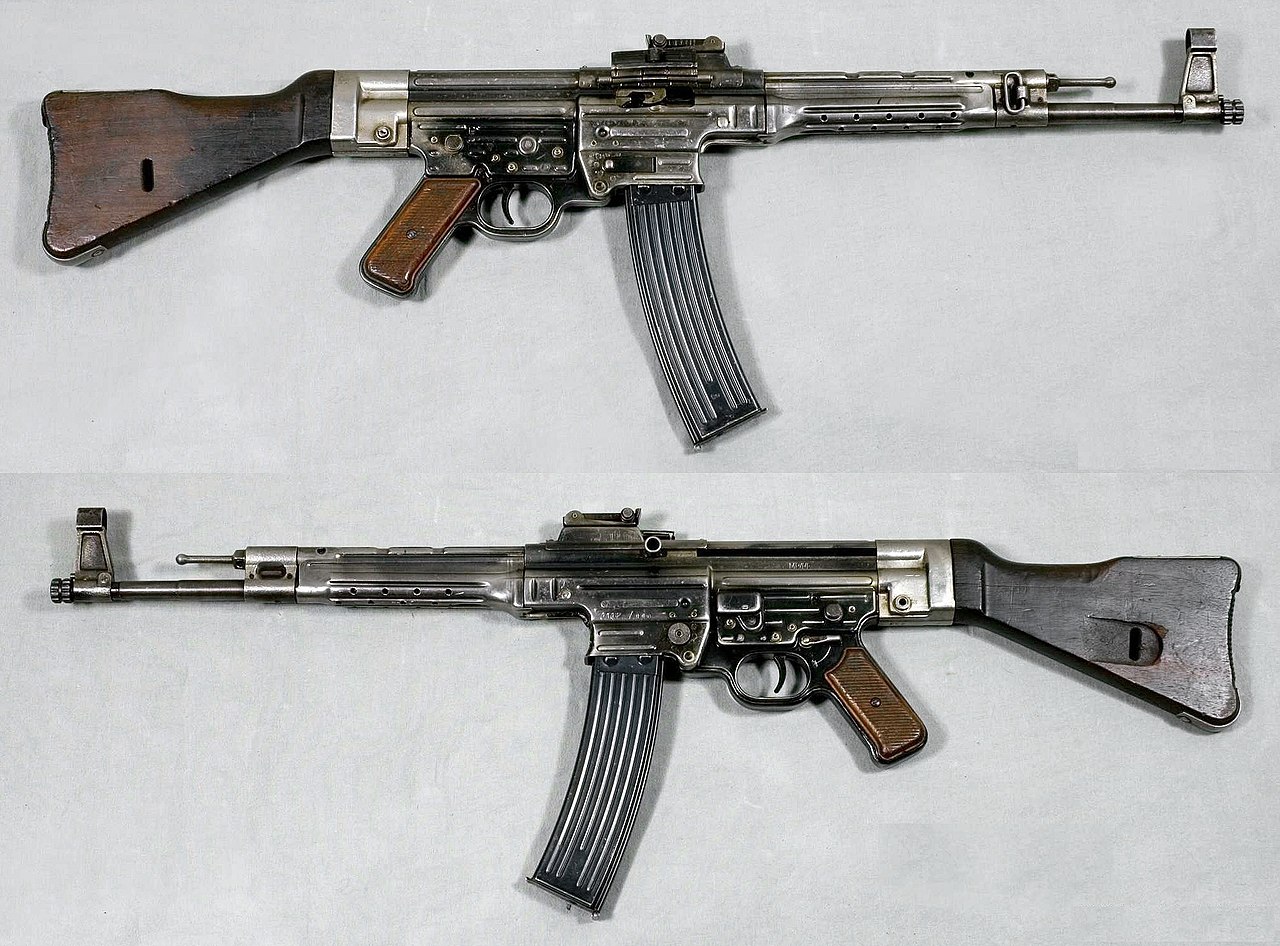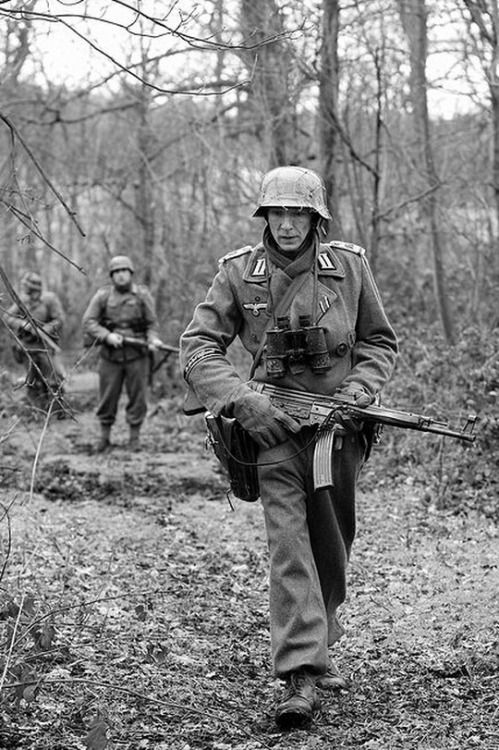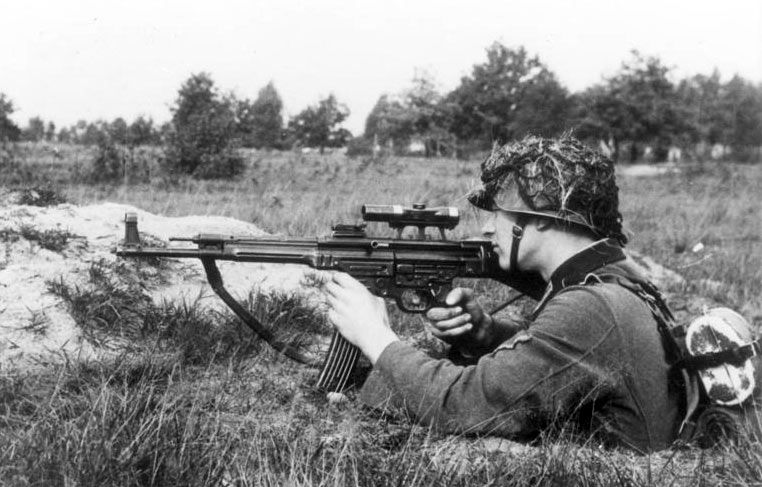
(A Waffen-SS soldier wields the StG 44)
During the Second World War, the German Wehrmacht primarily relied on bolt action rifles such as the Karabiner 98k as their main infantry weapon. These were augmented by light and submachine guns such as the MP40. By 1944 the German army had suffered devastating losses across Europe. On the Eastern front, the Soviets had countered the German invasion and had steadily been advancing towards Berlin. On the Western front, the Allies had made amphibious landings at Normandy. Germany’s defeat was inevitable. It was at this point that the Wehrmacht introduced the StG 44 Assault Rifle. Its introduction did not serve to change the course of the war but it had a resounding impact on the evolution of small-arms developments after the war. During my time at the RCMI, I’ve been lucky enough to handle such weapons and I’ve learned a great deal about their significance in military history.
Development
The bolt action rifles combined with the submachine guns were effective during the First World War when the rifles could be used to fire across no mans land while the SMG’s could be used to clear the trenches. With the advent of Blitzkrieg and the lightning pace of mechanized warfare during the Second World War, these needs became outdated. The infantrymen required a weapon which would allow them to lay down long waves of fire, especially on the Eastern front where the Soviets heavily outnumbered the Germans.
By 1942, Hugo Schmeisser developed the prototype for the assault rifle, dubbing it the MP-43. In April 1944, it was renamed the MP-44 and distributed to soldiers in small numbers. In late 1944 it was finally dubbed the StG 44 or the Sturmgewehr (Storm Gun) 44. The German industry pumped out 425,977 StG’s for the Wehrmacht until the end of the war.
Breakdown
 (The StG 44 Assault Rifle)
(The StG 44 Assault Rifle)
It utilized the intermediate 7.92x33 round, which fell squarely in between the 7.92x57 Mauser round used by the Kar 98 and the 9x19-millimeter round used by the MP series. This made it a weapon that fell in between the bolt action rifles and the SMGs. It also meant that while it was not as lethal and did not have as much range as the Kar 98, it was capable of fully automatic fire which is what made it significant. It was gas-operated through a piston working in a gas cylinder above the barrel and had a pistol grip, a wooden stock, a 30-round magazine and weighed just over 11 pounds.
Operational History
 (A German soldier with an StG 44)
(A German soldier with an StG 44)
Its effectiveness is difficult to measure largely because it came at a time when the war was arguably already lost. It could also not be produced in larger quantities because the Allies had already bombed and destroyed German factories and industries and had encroached on German territory. The StG arrived on the Eastern Front and was used to counter the Soviet’s SMGs. It was very effective in close combat and allowed soldiers to lay down suppressing and covering fire effectively. It was also utilized in the Ardennes Offensive where an analysis of two paratrooper division’s casualties highlights its effectiveness. In comparing the 3rd and the 5th Fallschirmjaeger divisions, the 5th division lost almost 9000 men during the offensive while the 3rd division lost around 2500. Why the difference? Both had been in combat together facing the same elements of the US army. The 3rd division had been allocated more StG’s than the 5th. What makes these numbers even more stunning is the fact that the 5th division had more artillery support and was numerically a larger unit.
 (A German soldier aims down a modified sight on the StG 44)
(A German soldier aims down a modified sight on the StG 44)
Significance
As the world’s first assault rifle the StG 44 stands as a superior and technologically advanced firearm. It has also had a significant effect on the development of modern firearms. Its development inspired the creation of the Soviet AK-47, one of the most mass-produced and replicated assault rifles in our modern world. The AK-47 has had a dramatic impact all across the world, utilized by various countries and terrorist groups. The Germans can be credited (for good or bad) with the revolutionary development of the world’s first assault rifle which has radically altered the shape of modern warfare.
(A brief history of the StG on the Youtube channel 'Forgotten Weapons')
By: Hammad Junejo
Bibliography
Cortese, Robert. "Combat Record of the Sturmgewehr 44." Small Arms Review. Accessed March 18, 2019. http://www.smallarmsreview.com/display.article.cfm?idarticles=2549.
Hickman, Kennedy. "World War II: Sturmgewehr 44 (StG44)." ThoughtCo. January 23, 2019. Accessed March 18, 2019. https://www.thoughtco.com/world-war-ii-sturmgewehr-44-stg44-2361247.
Hogg, Ian V. The Encyclopedia of Infantry Weapons of World War II. London: Arms and Armour Press, 1977.
Mizokami, Kyle. "The StG-44: Nazi Germany's Assault Rifle That Help Inspire the M4 Carbine." The National Interest. October 06, 2018. Accessed March 18, 2019. https://nationalinterest.org/blog/buzz/stg-44-nazi-germanys-assault-rifl....
